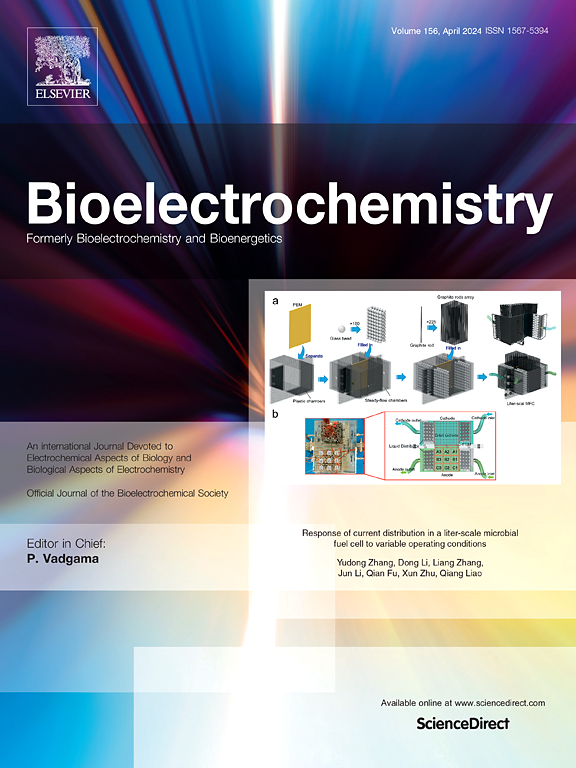Hybridization chain reaction and CRISPR/Cas12a-integrated biosensor for precise Ago2 detection
IF 4.8
2区 化学
Q1 BIOCHEMISTRY & MOLECULAR BIOLOGY
引用次数: 0
Abstract
This study introduces an innovative electrochemiluminescence (ECL) biosensor for the highly sensitive and specific detection of Argonaute 2 (Ago2) activity. Ago2, a key enzyme in the RNA interference (RNAi) pathway, plays a crucial role in gene regulation, and its dysregulation is associated with diseases such as cancer and viral infections. The biosensor integrates hybridization chain reaction (HCR) amplification and the CRISPR/Cas12a system, leveraging a multi-stage signal amplification strategy. The detection mechanism begins with Ago2-mediated cleavage of a designed hairpin RNA (HP-RNA), releasing single-stranded RNA (ssRNA) that triggers HCR. This amplification step generates long DNA polymers, which serve as activators for the CRISPR/Cas12a system. Cas12a's collateral cleavage activity amplifies the signal further by cleaving a DNA reporter labeled with a ruthenium-based luminophore, enhancing the ECL output. This dual amplification strategy achieves exceptional sensitivity, with a detection limit of 0.126 aM. The biosensor demonstrates excellent specificity, distinguishing Ago2 from other Argonaute proteins, and maintains high reproducibility and stability, retaining 94 % of its signal after two weeks of storage. Real-world applicability was confirmed by accurately detecting Ago2 in spiked cell lysates, with recovery rates exceeding 100 %. The combination of HCR, CRISPR/Cas12a, and ECL establishes a robust platform for biomarker detection, offering superior sensitivity and adaptability for clinical diagnostics, disease monitoring, and therapeutic evaluation. This biosensor represents a significant advancement in the development of next-generation diagnostic tools.

杂交链式反应和CRISPR/ cas12a集成生物传感器用于Ago2的精确检测
本研究介绍了一种创新的电化学发光(ECL)生物传感器,用于高灵敏度和特异性检测Ago2活性。Ago2是RNA干扰(RNAi)通路中的关键酶,在基因调控中起着至关重要的作用,其失调与癌症、病毒感染等疾病有关。该生物传感器集成了杂交链反应(HCR)扩增和CRISPR/Cas12a系统,利用多级信号扩增策略。HCR的检测机制始于ago2介导的发夹RNA (HP-RNA)裂解,释放单链RNA (ssRNA)触发HCR。这个扩增步骤产生长DNA聚合物,作为CRISPR/Cas12a系统的激活剂。Cas12a的侧切活性通过切割钌基发光团标记的DNA报告细胞进一步放大了信号,增强了ECL输出。这种双放大策略具有极高的灵敏度,检测限为0.126 aM。该生物传感器具有优异的特异性,可将Ago2与其他Argonaute蛋白区分开来,并保持高重现性和稳定性,在两周后仍保留94%的信号。通过准确检测加标细胞裂解物中的Ago2,证实了该方法在现实世界中的适用性,回收率超过100%。HCR、CRISPR/Cas12a和ECL的结合建立了一个强大的生物标志物检测平台,为临床诊断、疾病监测和治疗评估提供了卓越的灵敏度和适应性。这种生物传感器代表了下一代诊断工具发展的重大进步。
本文章由计算机程序翻译,如有差异,请以英文原文为准。
求助全文
约1分钟内获得全文
求助全文
来源期刊

Bioelectrochemistry
生物-电化学
CiteScore
9.10
自引率
6.00%
发文量
238
审稿时长
38 days
期刊介绍:
An International Journal Devoted to Electrochemical Aspects of Biology and Biological Aspects of Electrochemistry
Bioelectrochemistry is an international journal devoted to electrochemical principles in biology and biological aspects of electrochemistry. It publishes experimental and theoretical papers dealing with the electrochemical aspects of:
• Electrified interfaces (electric double layers, adsorption, electron transfer, protein electrochemistry, basic principles of biosensors, biosensor interfaces and bio-nanosensor design and construction.
• Electric and magnetic field effects (field-dependent processes, field interactions with molecules, intramolecular field effects, sensory systems for electric and magnetic fields, molecular and cellular mechanisms)
• Bioenergetics and signal transduction (energy conversion, photosynthetic and visual membranes)
• Biomembranes and model membranes (thermodynamics and mechanics, membrane transport, electroporation, fusion and insertion)
• Electrochemical applications in medicine and biotechnology (drug delivery and gene transfer to cells and tissues, iontophoresis, skin electroporation, injury and repair).
• Organization and use of arrays in-vitro and in-vivo, including as part of feedback control.
• Electrochemical interrogation of biofilms as generated by microorganisms and tissue reaction associated with medical implants.
 求助内容:
求助内容: 应助结果提醒方式:
应助结果提醒方式:


